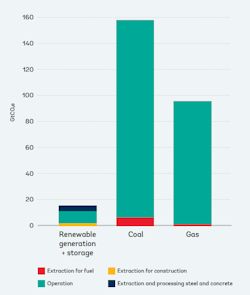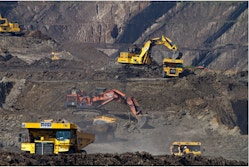Critical minerals, heroes of the energy transition
The global shift towards renewable energy has gained significant momentum in recent years and wind turbines, solar panels, electric vehicles, and energy storage systems have become synonymous with clean energy revolution. But while we focus on the advanced technologies and innovative designs that drive these solutions, we often overlook what makes it all possible: critical minerals.
Our energy expert and onboard scientist, Beatrice Cordiano, tells us more about these minerals and dispels some false myths about them.
When we think about the global transition to renewable energy, minerals may not be the first thing that pops up in our minds. However, they are a fundamental brick for various clean-energy technologies, from solar panels to wind turbines, from power lines to batteries, electric vehicles and much more. As the world aims to keep global warming to below 1.5 degrees Celsius compared to preindustrial levels, cutting in half greenhouse gas emissions by 2030 and achieving net-zero by 2050 becomes imperative. For this, we will need to drastically ramp up the production of all the technologies needed to make this transition happen and this is where critical minerals, or transition minerals, come into play.
These minerals are 50 minerals - metallic or non-metallic elements, including lithium, copper, nickel, cobalt and the so-called rare-earth elements - which are essential to the functioning of modern technologies and whose supply chain can be potentially disrupted. Mobile phones, computers, semi-conductor, aerospace and medical applications and low-emission technologies, our world is built around these minerals.

Critical raw materials
Keeping up with the mineral demand
Global climate goals have been set. The question is how we are going to get there. According to IRENA’s latest report, under a 1.5°C scenario, electricity generation would more than triple by 2050, with 91% of the total power supply coming from renewables, compared to 28% in 2020. That means adding renewable energy capacity, a lot of it, and build clean energy technologies, a lot of them.
Now, compared to their fossil counterparts, there is no doubt that these technologies have a significantly higher mineral demand: an electric car typically requires five times as much minerals as a conventional combustion-engine one, an onshore wind plant requires eight times more minerals compared to a gas-fired power plant of equivalent capacity, and a more efficient fossil fuel fired power plant requires way more nickel than its less efficient peer. We will need zinc for wind turbines, lithium for batteries, silicon for solar panels, copper for transmission lines, platinum for electrolysers and, if today the global demand for critical minerals used in clean energy technologies is about 7 Mt, by 2040 it seems that it could increase six-fold in a net-zero by 2050 scenario.

Mineral used in selected power generation technologies
So, as demand is growing faster than supply, will we run out of them? No, even if we are getting ready to mine huge quantities of minerals, the risk of running out of them in the near future is relatively low and that is because there is a difference between available reserves and resources: the first are the amount of minerals which is economically viable to mine, the latter is the total amount of minerals available worldwide, regardless of whether it is profitable to extract or not. Hence, minerals are not rare nor scarce - even if some of them are called rare-earth elements - they are just difficult or not cost-effective to extract.
Moreover, as a commodity becomes more valuable, two things happen: first, reserves increase as previously unprofitable resources become profitable, second, exploration and detection is intensified within the earth’s crust and the seabed, thus resources increase too. That is basically what happens already with fossil fuels and with any kind of resource. The actual problem may therefore not be whether there are enough transition minerals globally, but rather whether these minerals are readily available in the right places.
We all depend on a few
Minerals are not evenly distributed around the world and their production is currently way more concentrated than oil and gas. No country rules over the oil and gas markets like Australia, the Democratic Republic of Congo and China do over lithium, cobalt and rare earth elements: here, the top three producers control over 75% of the global market. And when it comes to platinum, a fundamental element in hydrogen technologies, South Africa is the undisputed leader, ensuring more than 70% of its extraction.
But even more than extraction, is processing operations which are highly concentrated in a handful of nations, among which China. The country stands out as the main refiner - processing 35% of nickel, 50-70% of lithium and cobalt and nearly 90% of rare earths - and a major player in the manufacture of intermediary products like batteries, solar PV and wind turbines’ components. Such geographic concentration means supplies are inevitably subject not only to geological and market constraints but also to regulatory oscillations, raising important worries regarding the vulnerability of global supply chain. So, whenever production stopped in one of these countries, disruption would be felt all over the world. In other words, geopolitics can speed up or slow down the race to net-zero.
The carbon footprint of mining
Another point which is often fairly raised is: how can the extraction of all these clean-energy transition minerals be sustainable, considering their outsized demand in the near future? Today - there is not denying it - metal production and refining are not very environmentally friendly and when it comes to critical minerals they are quite energy and carbon intensive : 3 tCO2eq are emitted for each ton of zinc, 4,8 for each ton of lithium carbonate and 16,7 for a ton cobalt sulfate.
However, when building clean technologies to increase renewable power generation capacity, the whole life-cycle emissions - from extraction to utilisation - need to be looked at and that’s here that we realise that the GHG emissions arising from the manufacturing cannot negate the climate benefits of these technologies.

Critical minerals
Global warming potential through 2050 for renewable electricity generation and energy storage technologies compared to fossil fuel technologies under a 2°C scenario
For instance, the total lifecycle emissions of EVs are around half those of internal combustion ones and this gap widens even more when using renewable electricity to power the mining industry and to run the vehicle. The advantage is clear and doesn’t leave a lot of room for doubts: the emissions created by extracting minerals are tiny compared to those generated by burning fossil fuels.
Critical minerals, bloody minerals
Industries avoid the discourse: the production of minerals used to make new technologies often finance bloody conflicts. The link between mining and conflicts is dated and intricate, yet, on the energy transition wave, apprehensions have arisen regarding the potential consequences this business has on human rights: child labour, modern slavery, poverty exacerbation and social exclusion.
There are no laws guaranteeing green technology manufacturing does not cause harm replacing one type of injustice with another - and it does, cause harm, at present. That’s the case of the unregulated cobalt mines in DRC, where kids toil in hazardous environments, of Chile’s salt flats where lithium deprives indigenous communities of water resources thus threatening crops, or of Mongolia, where the construction of the gold and copper mine of Oyu Tolgoi blocked corridors used by herders for generations.

The need for regulation has never been more pressing: countries must be transparent about the sourcing of the materials which feed their sustainable transition. Because, if it is to be sustainable – really sustainable – social security, inclusiveness and justice must be regarded on a par with environmental respect and economic stability: an interconnexion lying at the core of the 17 Sustainable Development Goals, as part of the 2030 Agenda established by the United Nations.
In a decarbonised world, critical minerals will be the backbone of our economies, and everything will be built upon them. They hold promise, if well regulated, to expedite the energy transition and empower the world’s most disadvantaged countries, lifting them out of poverty. Like every resource, their availability, geographical concentration and sustainable extraction might pose some challenges but, needless to say, the impact of their extraction will anyway be significantly smaller than what is already required to support a fossil-fuelled society.